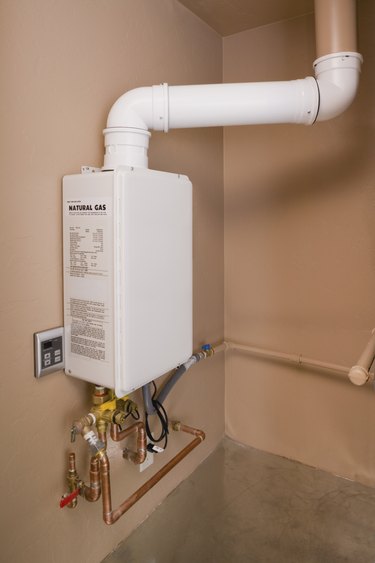 Tankless water heaters take up little space compared to tank-style models. Image Credit: Jupiterimages/Comstock/Getty Images
Tankless water heaters take up little space compared to tank-style models. Image Credit: Jupiterimages/Comstock/Getty Images
While traditional tank units keep gallons of water heated around the clock, tankless water heaters only heat water when you need it, which can help reduce energy costs. Although most homes require only one tank-style water heater, homeowners who plan to go tankless may find using multiple smaller units rather than a single large one improves performance and ensures hot water is always available when you need it.
Video of the Day
Capacity
Even the largest tankless water heaters can't supply enough hot water for multiple simultaneous uses in larger households, according to the U.S. Department of Energy. While some very large tankless units are advertised at flow rates of 9 or 10 gallons per minute (GPM), few actually provide this type of flow rate while still raising water to the desired temperature. To actually raise groundwater to 120 degrees Fahrenheit, most cut flow rate to well under the highest advertised rate, and may provide only a few gallons per minute. The DOE suggests using two or more tankless water heaters in larger households to achieve the desired level of hot water, or using dedicated tankless units at dishwashers and washing machines. FacilitiesNet suggests adding a second tankless unit when the demand for hot water exceeds 6 to 8 GPM.
Performance
Tankless water heaters start heating water only when you turn on a faucet, switch on the shower or start your dishwasher. There is a small delay from these actions before you actually receive hot water because the water heater is busy generating heat. If you have only a central tankless unit, you may find yourself waiting frequently for hot water at fixtures located far from the water heater. Using two or more tankless units means water has less distance to travel, resulting in faster hot water access at sinks, showers and other fixtures.
Efficiency
As you turn on the sink and wait for the tankless water heater to provide hot water, you allow cold water to flow down the drain. Adding a second tankless water heater means faster heat and less wasted water, according to the California Energy Commission. Multiple heaters also means shorter pipe runs, so less energy is wasted as hot water travels or cools down in the pipes.
Redundancy
If you have a single large tankless water heater and it fails, you'll be left without hot water until the unit is repaired. A second heater serves as a backup system so you're never completely without hot water, though flow rate and capacity likely will be cut in half.
Cost
Tankless water heaters cost $2,500 to $4,000 installed as of 2012, according to GreenBuildingAdvisor.com, and larger units generally cost more than small ones. Investing in two tankless water heaters rather than one likely will result in higher initial costs thanks to double equipment, installation, piping and ventilation expenses.







































